Snow Yoga
When we think of yoga, most of us visualize the classic setting of a dimly lit room with wall-to-wall mirrors, ambient music, and rows of jewel-tone mats spread across the floor. But more studios are taking their yoga outside as people seek the benefits of the outdoors: think yoga on stand-up paddleboards, yoga on the beach, yoga in the park… and here in winter-heavy Montana, yoga in the snow. Or, as it’s better known, “snowga”.
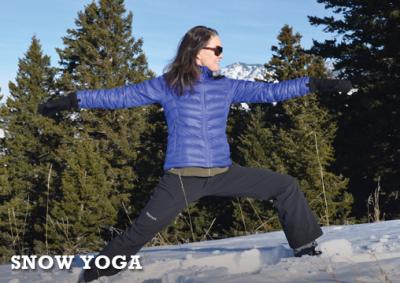
Jen Brick DuCharme, owner of Bozeman’s FLOW Outside, started bringing her yoga classes into the snow last winter. She has since seen an increasing interest in year-round outdoor practice. Snowga has been around for a few years, but FLOW Outside is still the only Montana studio offering the classes.
The past several years have seen an explosion of studies discussing the benefits of nature, and the adverse affects of spending too much time indoors. We know we need to be active in order to stay well, so if we’re trying to build a lifestyle of health and fitness, why not do it outdoors?
The health benefits of nature are something that people have long known and discussed. Studies show that spending time outdoors decreases stress, while increasing immunity and focus. More pertinent, it’s been shown that people have a decreased “perceived effort” when exercising outside versus indoors. Since the effort seems less, there is more potential for retention and building a lasting routine of fitness.
Consistent exercise in any form is good for you, and yoga is no exception. “There is proven stress release in the practice of yoga,” says Jen. “Moving meditation, especially outdoors, can help bring stress levels down.” Numerous studies show mind-body connection increases with consistent yoga practice. Yoga also improves posture, which aids in flow and circulation. The increase in circulation and energy helps with overall mobility, as well as flexibility and strength.
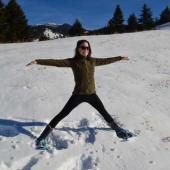
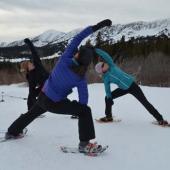
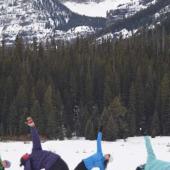

The most commonly asked question about snowga is in regards to the disparity between cold weather and flexibility. Most of us are taught that our muscles need to be warm in order to stretch, hence the deepened stretches sought in hot yoga. Jen has an answer to this valid inquiry, and it involves a 15-minute snowshoe to the location for her class, which works as a full-body warm up. Aside from being a warm-up, the snowshoe portion offers participants the ability to chat and meet like-minded community members, something not often afforded in classic indoor yoga, where excessive conversation is frowned upon.
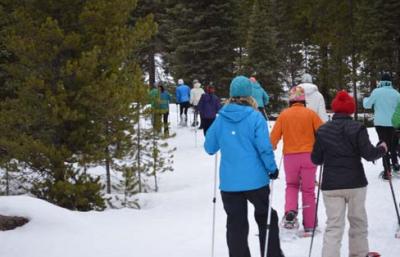
Snowga classes usually run between 45 minutes to an hour, depending on the location, studio, and weather. To maintain adequate body temperature, snowga participants are encouraged to wear multiple thin, synthetic layers that will wick sweat and allow flexibility. These can be taken on or off depending on how much heat is generated. Despite the warm up and the layering strategies, there are lower limits, and classes will not run if the temperature falls below 10 degrees.
The snowshoes remain on for the duration of FLOW Outside classes, which allows for a wider base for balancing poses. The snowshoes and poles also work as aids for helping people get into poses, and they can use the poles as balancing aids for trickier poses. Snowshoes aren’t a requirement for snowga as a whole — some studios bring mats outside, and some simply stomp out a flattish area in the snow.
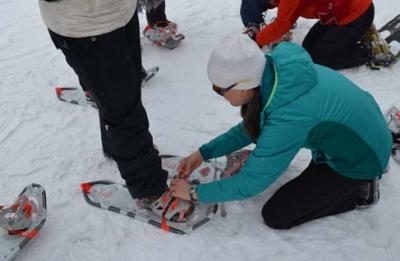
Jen utilizes several spots for FLOW’s snowga classes, including a wooded area by Mt. Ellis, and an open area on the same land with views of the surrounding mountains. Class members are enveloped by the serenity of the woods, views of surrounding mountains, and are able to create a mindful connection to the outdoors for the duration of class.
Aside from the mental and emotional benefits, doing yoga outside (in the snow or not) adds an additional level of balance challenge, as the ground is not perfectly smooth and flat like a studio floor… you may even find yourself on the side of a hill! Even this small change helps increase strength and stability throughout the poses.
For the most part, snowga classes follow a similar structure to indoor yoga classes, with minor adjustments. Snowga classes have fewer seated poses — it is in the snow, after all — but depending on the class, Jen and her participants lie down in the snow for Savasana, the relaxation period at the end of practice.
While FLOW Outside is currently the only studio in Montana offering snowga, the popularity is growing, and it’s likely that other studios will jump on board and take advantage of the snowy season. If you can’t make it to a class, give it a try yourself. Just make sure to get your muscles warmed up with a brisk walk beforehand, and have plenty of layers on hand to keep yourself bundled against the cold.
It can be tough to go outside during the winter. Daylight hours are shorter, and many winter sports are notoriously expensive. Snowga offers people the opportunity to get their exercise in an accessible location, inexpensively (snowshoes and poles are provided, and classes are around $15) and a chance to socialize.
So if the gym is getting boring and you don’t feel like driving to the ski hill, give something new a try — take your yoga practice outside. Namaste!












Leave a Comment Here